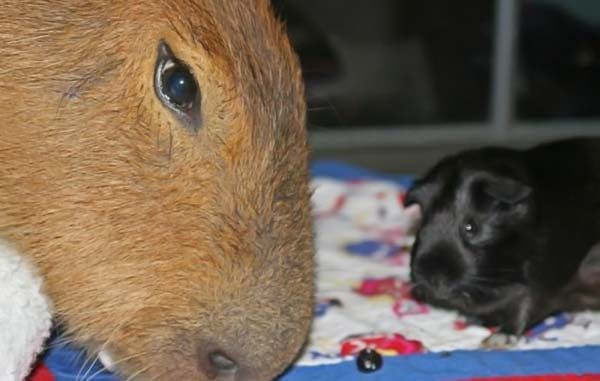|
|
Caplin Rous Capybara
|
Capybara have two different scent glands; a morillo, located on the snout, and an anal gland. Both sexes have those glands but males have larger morillos and their anal pockets can open more easily. The anal glands of males are also lined with detachable hairs. A crystalline form of scent secretion is coated on these hairs and are release when in contact with objects like plants. These hairs have a longer lasting scent mark and are tasted by other capybaras. A capybaras marks by rubbing its morillo on an object or by walking over a scrub and marking with its anal gland. A cabypara can spread its scent further by urinating. However females usually mark without urinating and mark less frequently than males overall. Females mark more often during the wet season when they are in estrus. In addition to objects, males will also mark females.
• Reproduction
When in estrus, the female's scent changes subtly and nearby males begin pursuit. In addition, a female will alert males that she is in estrus by emitting a whistling noise though her nostrils. During mating, the female has the advantage and mating choice. Capybaras mate only in the water and if a female does not want to mate with a certain male she will either submerge or leave the water. Dominant males are highly protective of the females, however they usually can’t prevent all the subordinates from copulating. The larger the group, the harder it is for the male to watch all the females. Dominant males secure significantly more matings than each subordinate, but subordinate males, as a class, are responsible for more matings than each dominant male. The lifespan of the capybara's sperm is longer than that of other rodents.
Capybara gestation is 130–150 days and usually produces a litter of four capybara babies, but may produce between two and eight in a single litter. Birth is on land and the female will rejoin the group within a few hours of delivering the newborn capybaras, who will join the group as soon as they are mobile. Within a week the young can eat grass, but will continue to suckle - from any female in the group - until weaned at about 16 weeks. Youngsters will form a group within the main group. Alloparenting has been observed in this species. The rainy season of April and May mark the peak breeding season. Like other rodents, the front teeth of capybaras grow continually to compensate for the constant wearing-down from eating grasses; their cheek teeth also grow continuously. When fully grown, a capybara will have coarse hair that is sparsely spread over their skin, making the capybara prone to sunburn. To prevent this, they may roll in mud to protect their skin from the sun.
|
|









